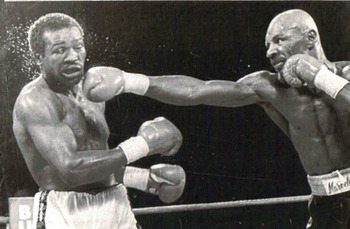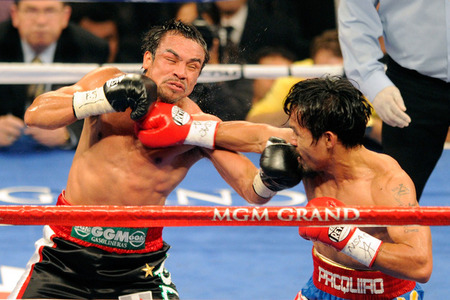 To face a southpaw is an awkward task for any orthodox boxer, but it’s not insurmountable so long as he/she is well-drilled in the awkward angles that the southpaw stance represents before they meet. One issue which can’t be addressed, however, is the fact that the southpaw will always be more comfortable fighting orthodox opponents than vice-versa. While the orthodox boxer can spar with southpaws and familiarise themselves as best they can with how to attack and defend effectively against a lefty, the southpaw, in contrast, has always worked with right-handed fighters in the gym. No matter what the orthodox boxer does, the southpaw has seen it before on countless occasions. This deficit in familiarity can be reduced to an extent, but never nullified.
To face a southpaw is an awkward task for any orthodox boxer, but it’s not insurmountable so long as he/she is well-drilled in the awkward angles that the southpaw stance represents before they meet. One issue which can’t be addressed, however, is the fact that the southpaw will always be more comfortable fighting orthodox opponents than vice-versa. While the orthodox boxer can spar with southpaws and familiarise themselves as best they can with how to attack and defend effectively against a lefty, the southpaw, in contrast, has always worked with right-handed fighters in the gym. No matter what the orthodox boxer does, the southpaw has seen it before on countless occasions. This deficit in familiarity can be reduced to an extent, but never nullified.First and foremost, the orthodox boxer must be suitably prepared for a battle of foot placement throughout the fight. Regardless of whether the southpaw is genuinely left-handed or a converted southpaw (a right-handed boxer who fights from the southpaw stance), he will always lead with his right foot, placing it outside the orthodox boxer’s left foot. If the orthodox doesn’t contest the foot placement and merely comes forward in straight lines, he/she risks walking into a straight left hand. To make matters worse, while the southpaw is able to land shots with both hands for as long as they hold the outside advantage, the orthodox fighter is reduced with regards to finding suitable angles with which to land shots with his leading left hand. This situation doesn’t change – unless the orthodox opponent moves to the left, placing their left foot outside the southpaw’s right foot. At this point, the orthodox fighter has the advantage for as long as they remain outside. He/she can land with either hand and the southpaw is unable to trade effectively. In particular, the orthodox opponent is able to throw a left hook to the body or head and the southpaw might not even get to see the shot until it lands. For as long as the orthodox is positioned this way, the southpaw’s guard is split and he is forced to pivot into his/her opponent if he is to have any chance of being able to land with his left hand.
Unfortunately for the orthodox boxer, moving to his/her left and constantly pursuing the positional advantage is something the southpaw is more than ready to adapt to if need be. Indeed, such predictable movement allows the southpaw to establish their jab with ease and in some cases, even walk their opponents on to a right hook, all while continuously adjusting and ensuring that the orthodox figher only ever has fleeting moments on their blind side. In short, the orthodox opponent doesn’t have enough time to make full of his/her advantages if the southpaw is already expecting it. For this reason, the orthodox need to keep the southpaw guessing with at least the threat of a different type of attack. Simply
stepping to the right occasionally, or throwing some shots while facing the south squarely, are two methods which can be effective in throwing the southpaw off.

Circling to the right is risky due to the fact that this entails movement within the punching range of a big left hand, but it is at least something which catches the attention of the southpaw and forces them to adjust. Not only can moving to the right allow for some good jabbing opportunities for the orthodox boxer, but if the southpaw is caught off guard and doesn’t adjust quicky enough, he/she can find themselves very vulnerable to an overhand right. In essence, the point of focus shifts and it allows the orthodox fighter to set the southpaw up for his/her right hand, or to pave the way for enough time to land left hooks whilst moving to the left.
Of course, to give the southpaw another thing to think about is to engage them squarely on occasion. Normally in this instance the orthodox opponent would work predominantly behind the jab when facing other right-handed fighters, but the situation is different. The angle is awkward and unfamiliar, as is the entanglement that often occurs when the orthodox leading left meets the leading right of a southpaw. For this reason, it’s not uncommon for southpaw to be able to out-jab an orthodox opponent who is more skilled than they are. Regardless of who is coming out on top in the jab battle, the orthodox opponent has the option of being able to setup combinations with the right hand. It’s the exact opposite of what would normally be effective, but the southpaw stance is more open to a straight right than it is to a left jab. As a result of this, starting a combination with the right hand is more difficult to defend against for the southpaw. He/she doesn’t know if the right hand is going to be a power shot or something to offset them. This is why orthodox opponents tend to throw a lot more fight hands than usual against the southpaw. Not only is it the most effective shot if it lands, but making the southpaw aware of it can allow for reduced awareness and/or slower reactions when moving to the left and possibly being able to setup a clean left hook.
While it is a method which is unfancied by the majority of coaches, an alternative way to box a southpaw is to face him square-on and refrain from contesting the southpaw’s foot placement for large periods of the fight. Seeing this usually means one of two things. Either the right-handed boxer isn’t comfortable with the side movement approach, or he doesn’t respect the southpaw’s punching power/punch resistance. If it’s the latter, the orthodox opponent and possibly even his/her coaching team are confident that the right hand will prevail. It’s a risky approach, especially as a Plan A, as even if it does surprise the southpaw, it doesn’t change the fact that the southpaw is more familiar with the angles. Despite the fact that in an orthodox vs orthodox encounter both straight and round punches can be defended against with the same defensive angle, it’s not the same story against the southpaw. Whereas the orthodox left hand may be defending against the southpaw jab, their right hook comes from another angle. The same things applies when comparing a left cross to an overhand left. Meanwhile, the southpaw is used to having to adjust their defence to deal with both straight and round punches. To make matters worse for the opponent who engages a southpaw squarely, if the he/she keeps their left foot inside for too long, the southpaw could come forward and move to their right – a bad situation for the orthodox fighter to find themselves in given that they are suddenly vulnerable to power shots that they”ll have little to no reacton time to defend against.
A decent southpaw is a difficult opponent for anyone and an orthodox boxer requires skill in order to beat them. In most cases, being able to keep one’s left foot on the outside of a southpaw’s right foot as much as possible translates to controlling the fight. Easier said than done, but it’s a feat made possible proving the right-handed boxer can mix it up effectively. Knowing when to move left/right is important in order to keep a southpaw off-balance and guessing, as is the aforementioned usage of the right hand, and knowing when it is most effectively utilised as a distraction, a setup punch, a power punch, or a counter shot. Catching a southpaw unawares with preparation disadvantages is tricky, but it’s what the orthodox boxer has to accomplish more often than not. Simply put, a southpaw opponent can be the bane of an orthodox boxer’s life and if all things are equal, it’s the southpaw who comes out on top.




